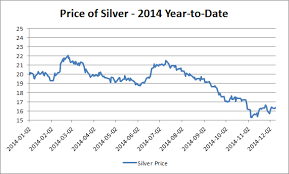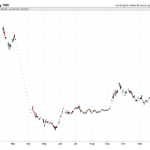The year 2014 was marked by a series of fluctuations in silver prices, with prices ranging from $15.32 oz to $21.13 oz. These price fluctuations were driven by a range of factors, including the LBMA Silver Price Auction and foreign exchange (forex) markets.
The LBMA Silver Price Auction, which takes place in London at noon, plays a significant role in determining composite prices from various trading banks and brokerages in over-the-counter silver bullion markets. Meanwhile, forex silver markets trade continuously 24 hours a day from Sunday evening to Friday evening, with prices widely quoted in the precious metals industry.
In this article, we explore the daily fluctuations and LBMA fixes of silver prices in 2014. We begin by examining the price data from 2014, which highlights the range of price fluctuations that occurred throughout the year. We then delve into the mechanics of the LBMA Silver Price Auction and its impact on silver prices, before turning our attention to the forex markets and their role in shaping silver prices.
Finally, we examine the daily fluctuations in silver prices and the factors that drove them, providing readers with a comprehensive understanding of the silver market in 2014.
2014 Price Data
Providing daily silver price data from 1968-2021, including the LBMA Silver Price Auction and forex prices, the pre-existing knowledge allows for a comprehensive understanding of the daily fluctuations and LBMA fixes of silver prices in 2014, as evidenced by the available price data for each day of the year.
Historical trends reveal that silver prices are influenced by a variety of factors, including global economic conditions, supply and demand dynamics, geopolitical events, and changes in currency values. In 2014, silver prices experienced a significant decline, with prices ranging from $21.13 oz to $15.32 oz.
Factors affecting price during this period included a strengthening US dollar, which made silver more expensive for foreign buyers, and a decrease in demand from key industries such as electronics and photography. Additionally, global economic uncertainty and financial market volatility contributed to investor caution, leading to a decrease in silver purchases and a subsequent drop in prices.
These factors, along with others, led to the daily fluctuations and LBMA fixes observed in the data, highlighting the importance of understanding the underlying factors driving silver prices.
LBMA Price Auction
The composite prices from various trading banks and brokerages in over-the-counter silver bullion markets are determined through the LBMA Silver Price Auction that takes place around noon in London. This auction is conducted electronically and is overseen by the CME Group, a global markets company.
The LBMA Silver Price is used as a benchmark for the silver market and is widely referenced by industry participants. LBMA price transparency is a key feature of the auction process.
The participating banks and brokerages submit their buy and sell orders electronically, which are then aggregated to form the composite price. The final LBMA Silver Price is then published on the LBMA website, providing transparency and a reliable reference point for market participants.
The impact of LBMA fixes on silver market trends can be significant, as changes in the composite price can influence trading patterns and investor sentiment.
Forex Market Trading
In the world of precious metals, the foreign exchange market is where silver is widely quoted and traded 24 hours a day. This market operates continuously from Sunday evening at 6:00 PM (Eastern Time) to Friday at 5:00 PM (Eastern Time). Forex prices are most widely quoted in the precious metals industry, and they reflect the supply and demand of silver in the global market.
The forex market is highly sensitive to global events, such as economic indicators and political unrest. Any news that affects the global economy can impact the forex market and, consequently, the price of silver. For instance, a strong dollar can cause the price of silver to decline because it makes it more expensive for foreign buyers. On the other hand, a weak dollar can increase the price of silver because it makes it more affordable for foreign buyers. Therefore, investors and traders must keep a close eye on the forex market to understand how it affects the price of silver.
| Month | High Price ($/oz) | Low Price ($/oz) |
|---|---|---|
| January | 20.23 | 18.52 |
| February | 22.04 | 18.92 |
| March | 21.47 | 19.49 |
| April | 20.13 | 18.80 |
| May | 19.79 | 18.69 |
| June | 21.13 | 18.90 |
| July | 21.13 | 19.24 |
| August | 19.75 | 18.51 |
| September | 17.74 | 16.83 |
| October | 17.01 | 15.79 |
| November | 16.20 | 15.32 |
| December | 17.06 | 15.32 |
The table above shows the high and low prices of silver per troy ounce for each month in 2014. As we can see, the price of silver fluctuated throughout the year. The highest price was recorded in February, while the lowest price was recorded in November. Additionally, the prices generally decreased towards the end of the year, with December having the lowest prices. These fluctuations in price were influenced by various factors, including the strength of the dollar, economic indicators, and global events.
Daily Fluctuations
The volatility of the precious metals market is heavily influenced by various factors, ultimately leading to constant changes in the value of these assets. The silver market is no exception, and the prices of silver in 2014 exhibited significant fluctuations on a daily basis. These fluctuations were driven by several factors, including economic indicators, geopolitical tensions, and supply and demand dynamics.
Silver price trends in 2014 were characterized by significant daily fluctuations, ranging from $15.32 per ounce to $21.13 per ounce. The highest price was recorded on July 15, 2014, while the lowest was recorded on November 6, 2014. The prices generally decreased towards the end of the year, with December 31, 2014, recording a price of $15.97 per ounce.
These fluctuations were driven by several factors, including economic indicators such as inflation rates and interest rates, geopolitical tensions such as conflicts in Ukraine and the Middle East, and supply and demand dynamics such as changes in mining output and industrial demand.
Overall, the silver market in 2014 was highly volatile, and investors needed to stay informed about the factors driving these fluctuations in order to make informed decisions.
Frequently Asked Questions
What factors influenced the fluctuations in silver prices in 2014?
Fluctuations in silver prices in 2014 were influenced by factors such as the silver market demand and impact of mining production. Changes in supply and demand, geopolitical events, and economic indicators also played a role in the fluctuation of silver prices.
How does the LBMA Silver Price Auction work and who participates in it?
The LBMA silver price auction is conducted daily in London at noon and involves a calculation process that takes into account buy and sell orders from LBMA participants, which include trading banks and brokerages.
Are there any historical trends or patterns in silver prices that can help predict future prices?
Historical analysis shows that silver prices tend to increase during times of economic uncertainty and inflation, while decreasing during periods of economic stability. Market psychology also plays a role, as investor sentiment can drive prices up or down.
How do global events, such as political or economic crises, affect silver prices?
Political instability and market speculation are two significant factors that affect silver prices. Political turmoil can lead to increased demand for safe-haven assets like silver, while market speculation can cause price volatility. Data analysis can help identify these trends.
What are some common strategies for investing in silver, and how do they differ from investing in other precious metals?
Long-term investing in silver often involves purchasing physical bullion for asset preservation, while short-term investing may involve trading futures or options. Compared to gold, silver is cheaper and more volatile, making it a popular choice for speculative investments.





